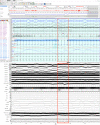A large collection of real-world pediatric sleep studies
- PMID: 35853958
- PMCID: PMC9296671
- DOI: 10.1038/s41597-022-01545-6
A large collection of real-world pediatric sleep studies
Abstract
Despite being crucial to health and quality of life, sleep-especially pediatric sleep-is not yet well understood. This is exacerbated by lack of access to sufficient pediatric sleep data with clinical annotation. In order to accelerate research on pediatric sleep and its connection to health, we create the Nationwide Children's Hospital (NCH) Sleep DataBank and publish it at Physionet and the National Sleep Research Resource (NSRR), which is a large sleep data common with physiological data, clinical data, and tools for analyses. The NCH Sleep DataBank consists of 3,984 polysomnography studies and over 5.6 million clinical observations on 3,673 unique patients between 2017 and 2019 at NCH. The novelties of this dataset include: (1) large-scale sleep dataset suitable for discovering new insights via data mining, (2) explicit focus on pediatric patients, (3) gathered in a real-world clinical setting, and (4) the accompanying rich set of clinical data. The NCH Sleep DataBank is a valuable resource for advancing automatic sleep scoring and real-time sleep disorder prediction, among many other potential scientific discoveries.
© 2022. The Author(s).
Conflict of interest statement
The authors declare no competing interests.
Figures



References
-
- Splaingard, M. L. & May, A. Sleep disturbances (nonspecific). In McInerny, T. K. et al. (eds.) American Academy of Pediatrics Textbook of Pediatric Care, chap. 194 (American Academy of Pediatrics, 2016).
-
- American Academy of Sleep Medicine. International classification of sleep disorders, 3rd edn (American Academy of Sleep Medicine, 2014).
Publication types
MeSH terms
Grants and funding
- R01 EB025018/EB/NIBIB NIH HHS/United States
- R01EB025018/U.S. Department of Health & Human Services | NIH | National Institute of Biomedical Imaging and Bioengineering (NIBIB)
- R01EB02501/U.S. Department of Health & Human Services | NIH | National Institute of Biomedical Imaging and Bioengineering (NIBIB)
LinkOut - more resources
Full Text Sources
Other Literature Sources
Medical

